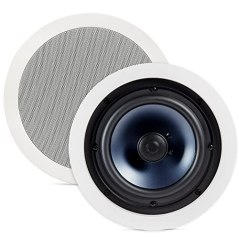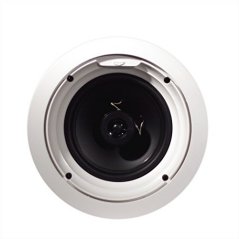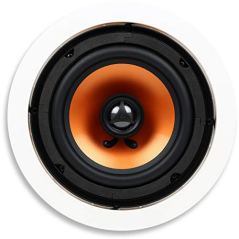Buying guide for best in-ceiling speakers
In-ceiling speakers are the way to go for the audiophile who wants great sound without having big, boxy speakers taking up floor space in the home or office. With the speakers mounted flush with the ceiling, most people won’t even notice them, and the sound will seem to come out of thin air and surround you. The surround sound quality of in-ceiling speakers can enhance any movie, too, giving you that immersive “you are there” feeling as you watch.
Size, tweeters, woofers—there are several factors to consider as you shop. You’ll also have to do some work installing in-ceiling speakers and running wires from the speakers to your stereo or home theater system, but the effort will be worth it. For a quality installation, you can pay a contractor to install them for you.
No matter which route you decide on, you still have to get the speakers first. Keep reading and we’ll walk you through everything you need to know to make the best decision. Check out our favorites, too.
Key considerations
Size
In-ceiling speakers generally come in two sizes: 6.5 inches and 8 inches (the surrounding case will be bigger, though). For instance, one set of 8-inch speakers measures 10 7/8 x 4 1/4 inches. Keep that in mind when you’re deciding where you’re going to install them.
Type
Tweeter: A tweeter is a small speaker that’s specially designed to reproduce higher-pitched tones (higher frequencies). Tweeters take it one step further by dispersing high-frequency sounds, so the entire room hears them correctly. High-frequency sounds are very directional, and without a tweeter you may not hear them if you’re not sitting in the right place.
Woofer: This is the most common speaker, producing a wide range of frequencies including most musical instruments, human voices, and sound effects. However, it may not be able to reproduce very high or very low frequencies.
Subwoofer: This is the big daddy that puts out the low-frequency sounds required by home theater systems, such as explosions or rumbling earthquakes. These speakers require some extra work to install, so it’s recommended that you hire a contractor if you get subwoofers.
Uses
Music: Woofers will be more than adequate for the vast majority of music most people listen to these days. If you’re not “most people” you may want to upgrade to a larger speaker set. It will cost more, but the sound quality will be worth it.
Home theater: As mentioned, the requirements for a home theater system are more involved than what most people need.
In-ceiling speaker features
Color
Most in-ceiling speakers are white or off-white. Many have grilles that can be painted to match your ceiling. Make sure you know which one you’re buying before you try to paint them, or you could wind up muffling the sound coming out of your speakers.
Indoor/outdoor
Indoor speakers don’t require any special gaskets to keep moisture out. Outdoor speakers, on the other hand, must have rubber gaskets and seals to prevent humidity and moisture from seeping in and damaging the circuitry. If you’re going to put in-ceiling speakers in your patio roof, make sure they’re outdoor speakers.
Frequency
Each manufacturer will list a range of frequencies for its speakers: 65 hertz to 22 kilohertz is the most common, but a slightly better range is 50 hertz to 28 kilohertz. This gives you more of the high-frequency directed sound as well as better output for special effects and deep bass tones. The wider the range the speaker can reproduce, the better the sound will be.
"If you paint the grilles on your speakers, first remove the fabric behind the grilles. Use spray paint to lightly and quickly spray the front. Let it dry before spraying on another coat. "
STAFF
BestReviews
Accessories
Speaker wire: You can’t have speakers without the wires to connect them to your stereo. If your speakers are mounted in the ceiling, you’ll need 50 to 100 feet of speaker wire. It’s better to have too much than not enough. AmazonBasics has a 100-foot spool of wire cable that is popular with consumers - and quite affordable.
Speaker in-ceiling brackets: Most in-ceiling speakers don’t come with brackets, so you’ll need to purchase them separately. We recommend getting an extra package when you do. If you make a mistake during the installation, you’ll be glad you don’t have to reorder. Monoprice sells an admirable installation kit that includes two brackets for eight-inch speakers.
Speaker wall brackets: On-ceiling speakers can be mounted in or on the wall. If you mount them on the wall, you’ll need some wall brackets, which are inexpensive and easy to install. VideoSecu’s bookshelf speaker mounting brackets, made of strong steel, are well-received by owners.
In-ceiling speaker prices
Inexpensive: At the low end of the price range, you can buy a pair of 6.5-inch speakers for $45 to $70. Occasionally, you’ll see a price of around $40, but closer inspection will show you that the price is for a single speaker (6.5 or 8 inches). You need to be aware of such merchandising tricks.
Mid-range: Spend between $70 and $120 and you can find high-quality, 8-inch speakers, some with paintable grilles.
Expensive: In the $130 and up range is where you’ll find indoor/outdoor speakers with extra gaskets and seals to keep out moisture, as well as expensive speakers with superior quality in both workmanship and sound reproduction.
Tips
- Space out the speakers evenly. In-ceiling speakers should be evenly spaced around the room. Don’t bunch them together at one end unless you’re using them for your television.
- Match the number of speakers to the size of the room. If your room is larger than 225 square feet, get two pairs of in-ceiling speakers, and space them evenly around the room. In large halls and meeting rooms, put one speaker every 15 feet. Try to match the speakers with the existing pattern of the ceiling lights for best results.
FAQ
Q. Can all speaker grilles be repainted to match the color of my ceiling?
A. Yes. Some specifically mention that fact, but most of them can be painted as long as you’re careful not to let the paint clog the holes in the grill, which would muffle the sound.
Q. What speaker wire should I use?
A. Each city has its own building codes, so you should check with your municipality to be sure, but CL2 or CL3 rated wires should be sufficient.
Q. How far apart should the speakers be installed on either side of my television?
A. The exact distance isn’t as important as making sure the speakers are equally spaced on either side of it.


















